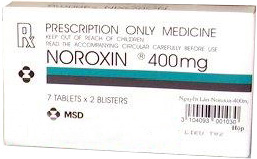Noroxin is a type of medication known as a fluoroquinolone antibiotic. It is used to treat various bacterial infections, including urinary tract infections, prostatitis, gonorrhea, and certain types of diarrhea. The active ingredient in Noroxin is norfloxacin, which works by killing the bacteria that cause infections. Noroxin is available in tablet form and should be used only with a prescription from a healthcare professional.
Restrictions
There are certain individuals who should not take Noroxin due to the potential risks and complications. These include:
- Individuals who are allergic to norfloxacin or other fluoroquinolone antibiotics
- Children under the age of 18 years
- Pregnant and breastfeeding women
- Individuals with a history of tendon disorders, such as tendonitis or tendon rupture
- People with a history of seizures or epilepsy
Adverse Reactions
Like all medications, Noroxin can cause certain side effects. Common side effects may include:
- Nausea and vomiting
- Digestive problems, such as diarrhea or abdominal pain
- Headache
- Dizziness or lightheadedness
- Changes in taste
In rare cases, Noroxin can cause more serious side effects, such as tendon rupture, allergic reactions, or symptoms of central nervous system disorders. It is important to seek medical attention if you experience any severe or persistent side effects while taking Noroxin.
Instructions for Noroxin
When taking Noroxin, it is important to follow the instructions provided by your healthcare professional. The usual recommended dose for adults is 400 mg taken every 12 hours, or as prescribed by your doctor. The tablets should be swallowed whole with a full glass of water, and can be taken with or without food.
If you miss a dose, take it as soon as you remember. However, if it is almost time for your next scheduled dose, skip the missed dose and continue with your regular dosing schedule. Do not take a double dose to make up for a missed one.
In case of a Noroxin overdose, seek immediate medical attention. Symptoms of an overdose may include dizziness, seizures, tremors, or loss of consciousness.
Interactions Guide
Noroxin may interact with other medications, resulting in potential complications or reduced effectiveness of either medication. It is important to inform your healthcare professional about all the medications you are currently taking, including prescription medications, over-the-counter drugs, and herbal supplements. Some known interactions with Noroxin include:
| Medication | Interaction |
|---|---|
| Antacids containing aluminum or magnesium | May reduce the absorption of Noroxin, therefore it is advised to take these medications at least 2 hours before or 2 hours after Noroxin |
| Warfarin | May increase the bleeding risk, and close monitoring of blood clotting parameters is advised |
| Theophylline | May increase the levels of theophylline in the blood, leading to potential side effects |
Ask and Answer
-
Can Noroxin be used to treat viral infections?
No, Noroxin is an antibiotic specifically used to treat bacterial infections and is not effective against viral infections. -
Can I drink alcohol while taking Noroxin?
It is generally recommended to avoid alcohol while taking Noroxin, as it may increase the risk of certain side effects and also reduce the effectiveness of the medication. -
How long should I take Noroxin?
The duration of Noroxin treatment depends on the type and severity of the infection. It is important to complete the full course of treatment prescribed by your healthcare professional, even if you start feeling better. -
Can Noroxin cause allergic reactions?
Yes, allergic reactions to Noroxin can occur. If you experience any signs of an allergic reaction, such as rash, itching, or swelling, seek immediate medical attention. -
Can Noroxin be used during pregnancy?
Noroxin should be avoided during pregnancy, as it may harm the developing fetus. If you become pregnant while taking Noroxin, inform your healthcare professional immediately.


Reviews
There are no reviews yet.